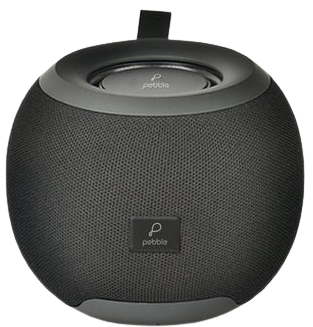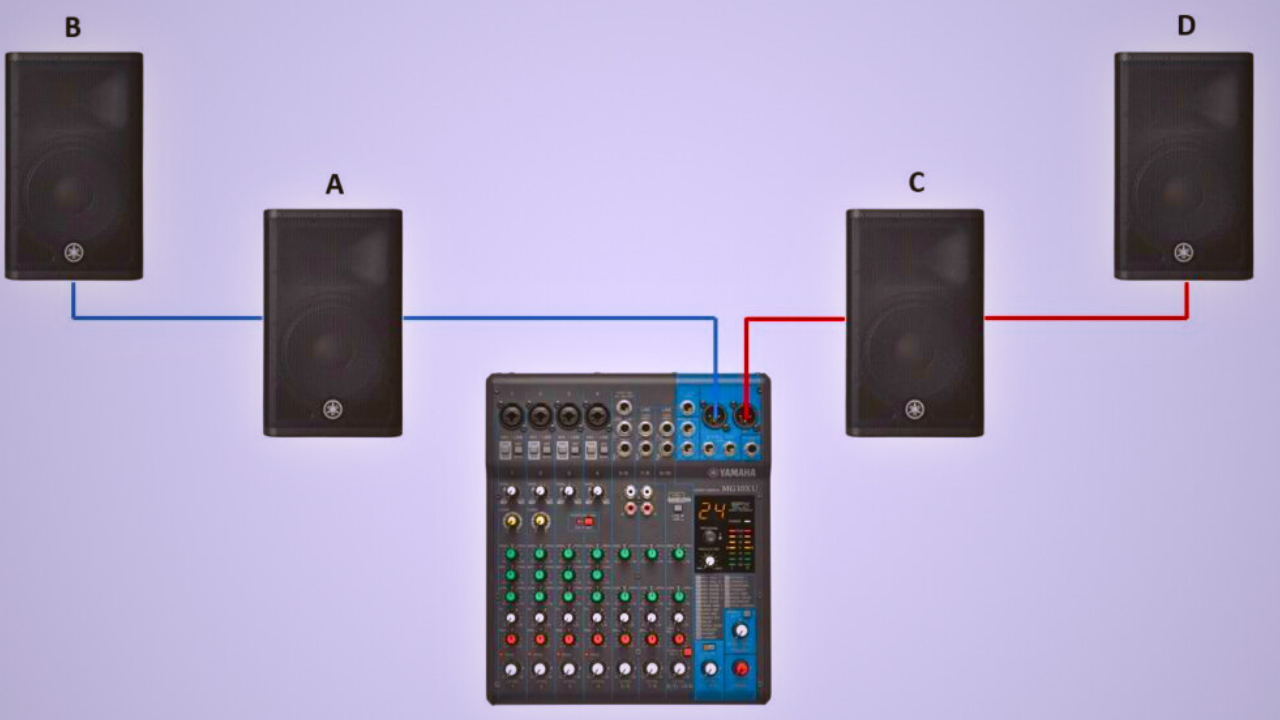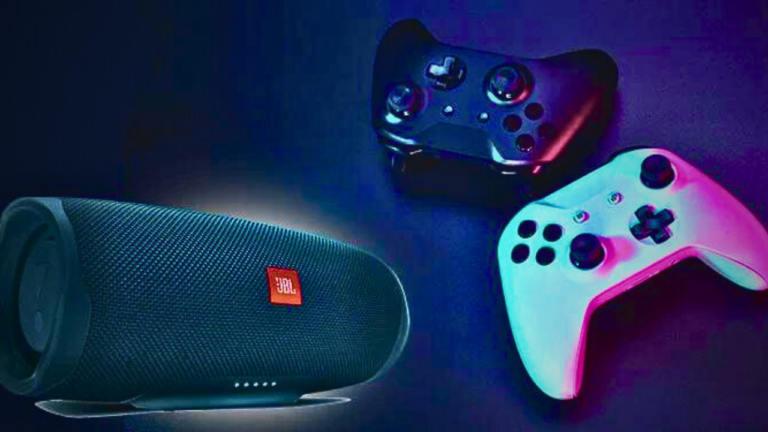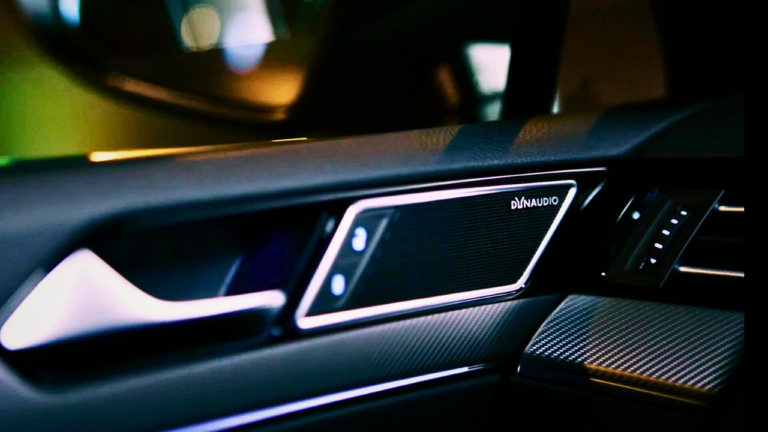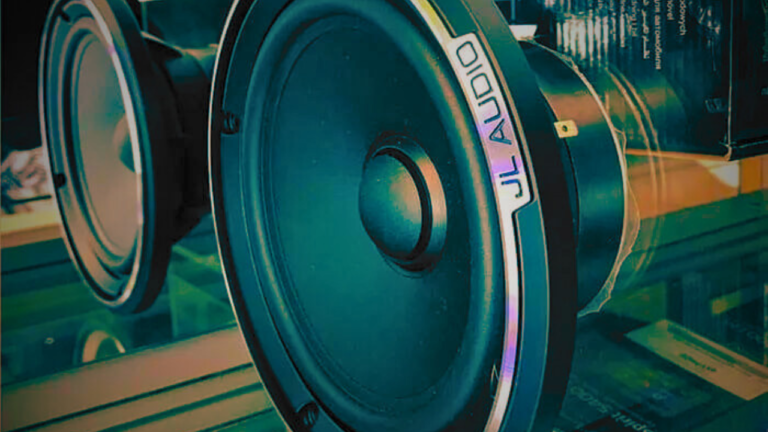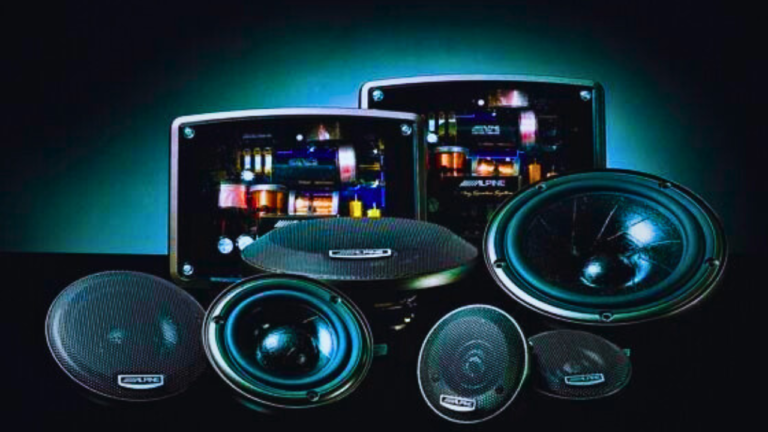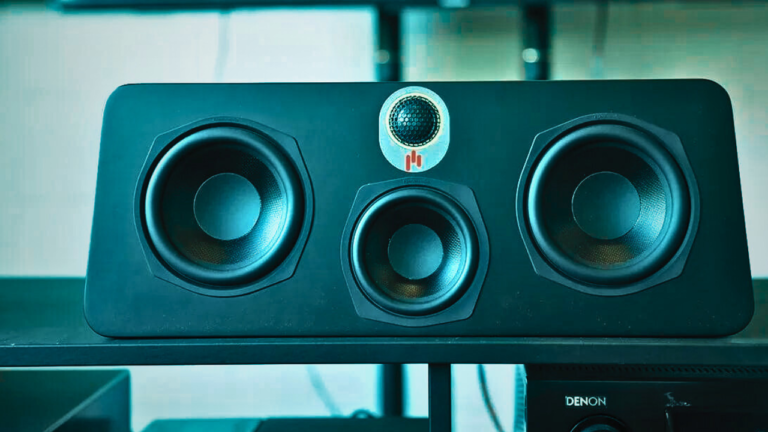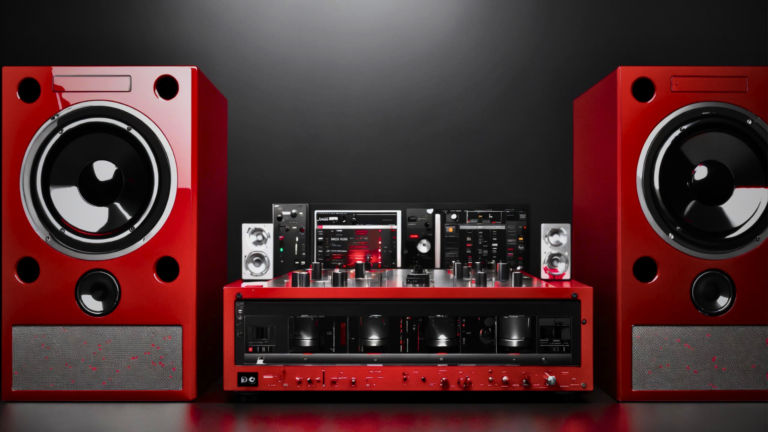How To Connect Passive Speakers To Mixer?
Let’s get deeper into the subject now that we have a clear grasp of what passive speakers are, how a mixer operates, and what kind of gear we need to connect the two. Do remember that your first concern should always be safety, just like with other electrical connections. Furthermore, even though the procedure is quite simple, extreme caution is necessary to prevent harm to your equipment.
Procedure for Attaching Passive Speakers to a Mixer
The following detailed instructions will make the process of connecting passive speakers to a mixer very simple:
- Examine your equipment. Make sure you have all the equipment we talked about earlier. It can save you from needless problems to have things ready in advance.
- Switch off the speakers and mixer. To prevent any electrical harm, ensure everything is off before you begin connecting wires.
- Link the speakers to the amplifier. Passive speakers require an amplifier to provide power because they are not self-sufficient. Use the proper cable to make the connection—typically a speaker wire.
Make the connection between the amplifier and mixer using an audio cable. This supplies the audio input that the passive speakers’ amplifier amplifies. - Verify the connections again. Make sure that everything has been connected correctly by giving everything one last inspection.
After everything is ready, turn on your speakers, amplifier, and mixer in that order.
Gaining complete control over your sound coordination is possible by understanding how to connect passive speakers to a mixer.
“Despite the seeming technicality involved, connecting passive speakers to a mixer can be carried out easily and efficiently with the right information and tools.”
In this search, the harmony between passive speakers and a mixer is very important.
Read also: Do In-Ceiling Speakers Need A Backbox?
Passive speakers: what are they?
As their name implies, passive speakers are those that need to be powered externally in order to operate. Passive speakers depend on an external amplifier, such as a mixer, for both their power supply and sound level control, in contrast to active speakers, which feature internal amplifiers. The speakers can produce sound because of this external component, which transmits the enhanced sound signal to them.
Thus, passive speakers are a preferred option for concerts, big events, or professional sound production settings where precise control over sound is required, even though they might need a little more setup than their active counterparts. Passive speakers also give the user more flexibility in terms of balancing and controlling the output sound.
Furthermore, because these speakers don’t have an integrated amplifier, they are lighter, more simply designed, and frequently more affordable, which makes them perfect for people on a tight budget or for events. But matching the passive speakers with the proper power amplifier—or, in this case, mixer—is essential for the best results.
How is a mixer operated?
Consider a mixer as the center where all audio signals converge and meld to create a harmonic output. Formally referred to as an audio mixing console, it combines many audio sources, equalizes them, and prepares them for output. Having a well-balanced sound is crucial, regardless of whether you’re in a live performance, recording studio, or even just having a party.
Primary Purposes of a Mixer
“What really happens inside a mixer?” one may wonder at this point. Although mixers are capable of doing many different jobs, the three primary ones are level adjusting, equalization (EQ), and panning.
Level Adjusting: A mixer’s primary purpose is this. It modifies the intensity or volume of every incoming sound source. This gives you the ability to adjust the proportions between several voices or instruments so that none overpowers the others.
Equalization: The magic happens during equalization. You can adjust the tone of the sound emanating from your various sound sources with the use of equalization (EQ). You may do this to increase or decrease particular frequencies in a sound. This feature aids in adjusting the total sound output so that it is more aesthetically pleasing and well-balanced.
The last step in creating a stereo sound system is panning, which is the distribution of audio signals between the left and right channels. This creates a more expansive and immersive soundscape by adding a sense of directionality to the sound production.
The Foundations of Mixer Function: Routing
In addition to these key roles, a mixer plays a significant part in routing. Routing determines where each sound is sent by directing the signal routes inside the mixer. It lets you send signals to external processing devices like effects pedals or signal processors, or it can be used to group similar sound sources together or send individual tracks to distinct outputs.
Thus, the mixer serves several purposes when passive speakers are connected to it. It combines the sound, equalizes it, fine-tunes it, and directs it to the speakers for a smooth, pleasing audio experience. That’s quite a fantastic concoction, don’t you think?
What tools are required to connect a mixer to passive speakers?

Let’s get started responding to your question, “What equipment is needed to connect passive speakers to a mixer?” The procedure can appear complicated at first, but it’s actually quite simple after we get beyond the technicalities. A few specialized tools are required:
- Passive speakers: Speakers that need an external power source to function are known as passive speakers. They don’t have an integrated amplifier, but they can produce excellent sound.
- Mixer: This apparatus adjusts audio characteristics, balances sound, and controls inputs. It guarantees that the right amount of sound is sent to the speakers.
- Amplifier: An amplifier is used to provide the necessary external power for passive speakers. Before the audio signals from the mixer go to your speakers, it enhances them.
- Speaker cables: These are necessary for sending audio signals from amplifiers to passive speakers. Seek out robust cables intended for use with high-end audio equipment.
- Cables, either XLR or RCA: Your mixer’s outputs and amplifier’s inputs will determine which type of cable you require for the connection: RCA or XLR.
Possessing these tools will place you in a powerful position to take on the issue at hand. Let’s talk about the process of making everything work together now.
Read also: Why Do Speakers Have Magnets?
What typical issues arise when passive speakers are connected to a mixer?
Some common problems might arise when connecting passive speakers to a mixer, especially for people who are not familiar with audio. Fortunately, the majority of issues are simple to solve with a little expertise.
1. Improper Wiring Configuration
Many problems arise when the wiring is not installed appropriately. Problems can range from utilizing the wrong kind of cords to attaching the wires to your equipment in the wrong way. Make sure you closely adhere to the manufacturer’s instructions and confirm that all connections have been set up correctly before you start broadcasting in order to avoid these issues.
2. Inconsistent Power Outputs
A sometimes disregarded but vital aspect of system configuration is guaranteeing that the power outputs of your mixer and speakers are equal. Employing a speaker with a lower power rating could cause overloading and, in extreme situations, could even damage your components. Conversely, using a speaker with a higher power rating than your mixer could result in insufficient sound output.
3. Insufficient Volume Management
Inadequate control over volume levels is another common issue customers run into when using passive speakers with a mixer. Wavering volume levels and distortions in sound can result from an audio mixer that is not set up properly. Use the EQ settings and volume knobs on your mixer appropriately to solve these problems.
4. Incompatibility of Interfaces
Incompatibility of the interface may potentially be an issue. It is hard to connect speakers and mixers directly without the appropriate adapter or cable because not all of them have compatible connection interfaces. Make sure the inputs on your passive speakers and the mixer’s outputs are compatible before making your equipment purchase.
To summarize, anticipating and comprehending the typical issues that arise when attaching passive speakers to a mixer will ultimately spare you a great deal of trouble and wasted time. If you encounter any problems, don’t be afraid to refer to the handbook for your device or get expert assistance.
What are the advantages of using a mixer to link passive speakers?

Let’s examine the benefits of using a mixer to connect passive speakers. The ability to adjust and exert control is the main advantage here. By efficiently controlling the sound, a mixer raises the bar for recording and listening experiences.
Customized Sound Quality: By connecting your passive speakers to a mixer, you may change the loudness and tone of the sound to suit your preferences. In this manner, you can adjust the sound output until it precisely fits your preferred audio profile.
Enhanced Clarity: You’ll experience a noticeable increase in audio clarity when passive speakers are linked to a mixer. By adjusting various sound frequencies, you can lessen distortions and improve the overall sound quality.
Simple Integration: Several devices can be easily integrated with a mixer. This facilitates the process of connecting the passive speakers to other audio components in your system, including recording devices, instruments, and microphones.
Dynamic Controls: You can regulate the sound output of your passive speakers in a dynamic way by using a mixer. This quality is quite helpful, particularly when performing live or recording.
| Benefit | Description |
|---|---|
| Total Control Over Sound Quality | A mixer gives you the freedom to adjust audio properties such as volume, tone, and pitch. This can lead to higher-quality sound, especially in environments with challenging acoustics. |
| Set and Forget Functionality | Once the mixer is set up, it can continuously manage the audio without requiring constant attention. This saves time and allows for consistent audio quality. |
| Ability to Mix Multiple Inputs | Mixers can handle multiple audio sources at once. This is particularly useful in situations where you need to balance the audio levels of several different inputs, such as in a band or a panel discussion. |
| Optimized Power Distribution | Connecting passive speakers to a mixer allows for the correct distribution of power, preventing potential damage to the speakers due to overloading. |
| Scalability | Using a mixer allows for easy expansion of your audio setup. Additional speakers or sound sources can be added without needing to completely redesign the sound system. |
In summary, the act of linking passive speakers with a mixer not only elevates the quality of your audio setup but also enables you to enjoy a more customized, improved, and interactive music experience.
In summary
In conclusion, if you’re unfamiliar with the sound and audio industry, connecting passive speakers to a mixer may at first appear like a difficult undertaking. You are, however, halfway there if you have a solid grasp of passive speakers, the operation of a mixer, and the appropriate hardware. Never forget that for a smooth audio flow, appropriate configuration and matched power outputs are essential.
Undoubtedly, there may be a few obstacles in the way, such as insufficient volume control or incompatibility with certain interfaces. But don’t worry! These are widespread issues for which there are remedies.
Additionally, once these flaws are fixed, the advantages of your arrangement will greatly exceed the difficulties. A few benefits you’ll experience are crisper audio, more control over audio delivery, and the flexibility to personalize your audio mix.
So feel free to try new things. After you get the hang of connecting your passive speakers to a mixer, it can take some practice and some trial and error, but the work will be well worth it. You’ll soon be able to experience rich, lively, and captivating sound depth.
You can use audio mixing to enhance your personal experience at home, add energy to business presentations, or even throw an unforgettable beach party—the possibilities are endless once you have mastered the technique!
Read also: What Amp Do I Need For 100W Speakers?
FAQs
What purpose does an amplifier serve in this configuration?
The function of an amplifier is vital because it raises the mixer’s low-level audio signals to a level at which passive speakers can produce sound. Your passive speakers wouldn’t be able to produce sound efficiently without an amplifier.
Is it possible to link a mixer to active speakers?
You certainly can. Since active speakers come with built-in amplifiers, you can connect them to your mixer directly and forego the need for a separate amplifier.
How can I distinguish between passive and active speakers?
Speakers that need an external power source are usually considered active. Conversely, since passive speakers draw their power from the attached amplifier, they are exempt from this requirement.
Does every mixer require an amplifier?
Not every mixer requires an amplifier. Amps are integrated into some mixers, sometimes referred to as powered mixers. Nevertheless, the great majority of mixers are unpowered models, meaning that passive speakers must be powered by an external amplifier .
Is a mixer required for every passive speaker?
Not always. While a mixer allows you to control many inputs, change live, and balance your sound, if you’re handling a single source of audio, a passive speaker and amplifier can function just as well.
What can I do to stop my passive speakers from humming?
Buzzes and hums are usually related to electromagnetic interference or problems with grounding. Aim to keep power lines and other possible sources of interference away from your audio cords, and make sure that all of your equipment is grounded correctly.
To connect my passive speakers to a mixer, what wires do I need?
XLR or 1/4″ cables are normally required, but this could change depending on your equipment. Prior to buying any wires, make sure your mixer and speakers are connected correctly.
With my mixer, how many passive speakers can I connect?
This is entirely dependent on how many outputs your amplifier and mixer have. Remember that each speaker will need its own output, so make sure to arrange your setup appropriately.
Can my passive speakers be connected to a mixer without the need for an amplifier?
You cannot, I repeat. A normal mixer cannot supply the amplification source needed for passive speakers to produce sound. For this, a powered mixer would be required.
Even when everything is connected perfectly, there is no sound. What might be the problem?
There could be a number of causes, including faulty wiring, incorrect configurations, or broken equipment. To begin troubleshooting, examine each part and setting separately.

Hey there! I’m Henry Jack, the voice behind speakerrealm.com, your ultimate destination for everything speakers. Whether you’re a seasoned audio enthusiast or just starting to explore the world of sound, you’ve come to the right place.
At Speaker Realm, I dive deep into the realm of speakers, bringing you comprehensive reviews, insightful guides, and the latest trends in the industry. From floor-standing behemoths to compact bookshelf wonders, I cover it all.
I’m passionate about helping you find the perfect speakers to elevate your audio experience. Whether you’re setting up a home theater, upgrading your sound system, or just looking for some quality audio gear, I’ve got you covered.
But Speaker Realm isn’t just about technical specs and performance metrics—it’s also about the art and science of sound. I explore topics like acoustic design, speaker technology, and the impact of audio on our lives.
So whether you’re a casual listener or a hardcore audiophile, join me on this journey through the world of speakers. Let’s turn up the volume and explore the endless possibilities of sound together at speakerrealm.com!
